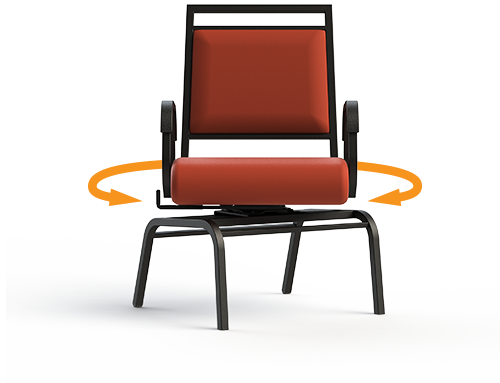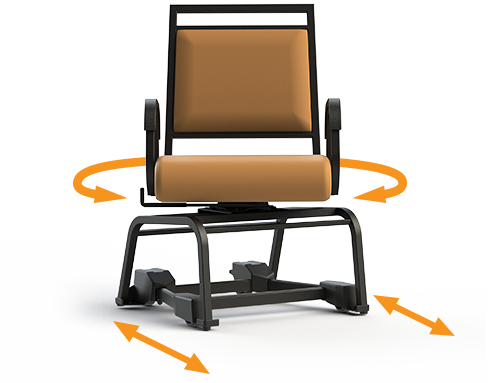Parkinson’s, Caregivers, and Mealtime:
Why dining chairs need to swivel…turn…roll…and lock for safety
Caring for someone living with Parkinson’s is a daunting challenge for both family members and professional caregivers. Mealtimes can be especially challenging as persons with Parkinson’s are at risk of falling from the neurological disorder which causes uncontrolled movements including: shaking, stiffness and difficulty with balance and coordination.
Caregivers too experience constant stress and anxiety as they monitor a loved ones actions. Any attempt by their loved one to get seated on their own is likely to result in a fall or injury.



The Challenge in the Dining Room

While the process of being seated at the table is routine for many of us, the process of seating a person with Parkinson’s at the table involves two distinct and separate steps that need to be understood by the family and caregiver.
Step 1: Getting seated in the chair
It is not uncommon for a person with Parkinson’s to bump into furniture while attempting to get seated in a chair. This can have disastrous results, as any unintended contact with the chair can cause it to move unexpectedly, often resulting in a fall or injury.
Unfortunately, traditional chairs fail both seniors and caregivers

as a standard dining chair is not designed to
move,
putting the caregiver at risk of incurring
a personal injury
as a result of overexertion,
while...

the office/task chair is designed to roll too
easily (not stable)
putting the
seated person at risk of incurring a injury due to a
fall
when the chair moves unexpectedly.
Step 2: Being moved up-to and away-from the table
Once seated, the physical demands required to move a seated person up to the table can be exhausting for the caregiver. Any activity which involves pushing, pulling, shoving, and twisting of the seated person serves only to increase mealtime stress and anxiety for both seated person and caregiver.
A Better Way
Dining chairs designed for today’s seniors and caregivers must include features enabling the chair to swivel…turn…roll…and lock for safety, thereby reducing the risk of injury for both the seated person and the caregiver!
Chairs that swivel and lock eliminate table interference as the seat of the chair is swiveled 90 degrees away from the table.
This allows full access to the seat of the chair for the person being seated. Once they are comfortably in the chair, they can release the swivel lock and rotate themselves towards the table.
Additionally, chairs that also roll and brake for safety can be moved even further from the table, providing increased clearance, should a second caregiver be required when transferring the person into the seat of the chair.
Once seated, they can be rotated back towards the table, and the caregiver effortlessly glides them into position at the table before securing the brakes.

Exiting the table: With the seat of the chair
turned (90 degrees) away from the table, the seated person is
also able to rise from the chair and walk directly away from
the table.
This eliminates the need for the person
to lean on the table and shuffle/pivot his/her feet as they
reach for their walker.
Creating Efficient Lifestyle Spaces
Moving between tables can be challenging for persons living with Parkinson’s, as this typically involves being assisted/transferred from one chair to another.
When the controlled inline mobility of the chair/CADDIE is combined with a swivel-seat that locks every 90 degrees a seated person can move safely between two tables, eliminating the need to transfer into another chair, thereby minimizing the risk of fall/injury to either the seated person or the care provider.
Place the swivel chair/CADDIE between two tables. Rotate the seat of the chair to face away from either table. In this position the swivel seat is locked enabling a person to be seated or assisted into the chair without any interference with the table or fear of the chair moving unexpectantly.
From this position the seated person can rotate/lock the seat of the chair 90 degree LEFT to access one of the tables. The seated person can also rotate/lock the seat of the chair 90 degrees RIGHT to access the 2nd table. While seated and facing either table, the inline mobility of the chair/CADDIE allows the seated person to independently roll the chair towards the table of choice.
To exit the chair, simply rotate the swivel seat to once again face away from either table. When the swivel-seat locks, the seated person rises safely out of the chair and walks directly away from the chair.
Why is a heavier chair safer when caring for a person with Parkinson’s?
At first glance, caregivers assigned the task of moving a seated person up to the table opt for a lightweight chair, thinking this will ease their effort when moving that person forward.
However, what they fail to appreciate is (a) once the person is seated, it is the total weight of the person and the chair that needs to be moved up-to the table, and (b) a lightweight chair tends to move prematurely, increasing the risk of injury to the person being seated.
Caregivers should consider selecting a chair designed both for stability and mobility. A sturdy chair with arms offers support as the person slowly lowers him/herself into the chair. A heavier chair provides increased stability and thus is less likely to move prematurely. Chairs fitted with lockable inline wheels provide needed mobility, enabling the caregiver to roll the seated person up-to the table with ease and grace.
Chairs that Swivel...Turn...Roll...and Brake for safety:
- provide those with Parkinson’s a greater degree of dignity and self-worth
- eliminate the need for care partners to push-pull-shove-twist on a chair
- reduce mealtime stress and anxiety for both the seated person and the care partner
- create a more enjoyable mealtime routine for all
Meet Patricia...
My husband has Parkinson’s Disease and has broken 2 chairs trying to get close enough to the table to eat. This mobility chair is the best. So easy to sit him at the table now.
Swivel & Roll - Merriville, IN
Meet Rose...
This chair has been a lifesaver. My husband has
progressive Parkinson's Disease and needs 24-hour
assistance. We could not find a chair that would fit his
needs. An office chair with wheels was not an option
because it flew off whenever he was rising or sitting
down. To turn a regular chair away from the table, it
had to be lifted with him in it.
With the
stiffness caused by his illness, he could not help, thus
the chair was dragged and quite a number of chairs got
broken (along with the floor being damaged.) After days
of online research, I came across your chair. It has
been life-altering. I have recommended this chair to so
many people who are afflicted the same way he is.
Swivel & Roll - New York, NY
Dining chairs recommended for Parkinson's care.





